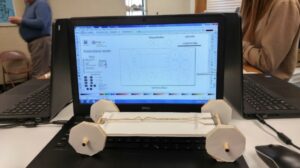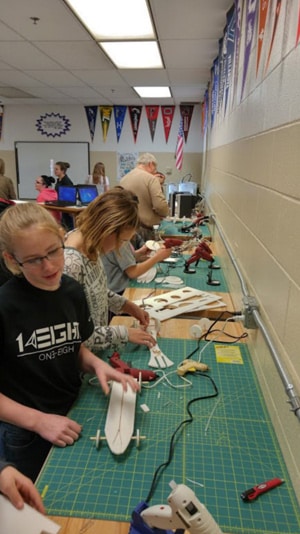Overview
STEM careers
Time
Materials
Per Whole Group:
|
Per Team:
|
Relevant Terminology
Friction: The resistance of one object that is rubbing against or moving along another one.
Potential energy: Stored energy. Stretching a rubber band stores potential energy.
Kinetic energy: Energy of motion. The rovers transform potential energy in the stretched rubber band into kinetic energy (spinning wheels).
Introduce
GETTING READY
This activity is designed to be run in a Fab Lab. (What is a Fab Lab? See: fabfoundation.org/index.php/what-is-a-fab-lab/index.html). It is assumed that the facilitator and adult helpers have a working knowledge of 2D design and the safe use of a laser cutter.

A rubber band rover designed using Inkscape. The rubber bands that cover the edges of the wheels increase friction between the wheels and the floor. Credit: John Doctorick/Carnegie Science Center.
Organize materials by team and ensure that there is enough workspace for teams to construct their rovers. Find a place to test rovers, such as a long hallway, and mark a starting line with masking tape. You may wish to make an example rover in advance.
Optional: Create a rover template that participants can edit.
INTRODUCTION
Introduce the activity by asking, “What do you call a car that drives on another planet?” The answer: a rover! NASA builds robotic rovers that can explore other planets without risking the lives of astronauts. Rovers have wheels that are designed to handle uneven terrain, as well as tools to collect scientific data. To get participants thinking about this design challenge, ask questions such as:
- What makes the wheels on a car spin? Answers might include, but are not limited to:
- The engine burns fuel, turns the driveshaft, spins the axle, and so forth.
- A car turns chemical potential energy (gasoline) into kinetic energy (spinning wheels).
- What are some other ways to get a wheel spinning? (gravity/rolling, falling water, bicycle chain, electric-powered motor, solar-powered motor)
- What energy source could a rover on another planet use to spin its wheels? (solar power, nuclear power, wind)
Instructions

Participants build and test their rubber band rovers. Credit: John Doctorick/Carnegie Science Center.
Introduce the design challenge: Participants work in teams of 2–3 to design a rubber band-powered rover to travel as far as possible on a flat surface. Give participants the following constraints:
- Each rover must consist of a body and wheels made of cardboard.
- You may use up to two rubber bands to power your rover.
- You may NOT use tape.
- Organize participants into teams.
- Introduce the software. If necessary, provide a software tutorial to the group. Teams should know how to make simple shapes (rectangles, circles) and how to send files to the laser cutter. Younger participants may require assistance saving their files and sending them to the laser cutter.
- Instruct participants to design the rover according to these steps:
- Use 2D design software to design a body and wheels for your rover.
- Send the file to the laser cutter (assist participants if necessary). A trained adult will operate the laser cutter.
- Distribute building materials to teams after the rover has been cut out.
- Tell teams to build the rover. Provide the following instructions:
- Use straws, dowels, or pencils to make an axle for the wheels.
- Wrap a rubber band around an axle and stretch it to a fixed point on the rover. Use a notch or other design element to secure the rubber band.
- Rotate the axle so that it winds up the rubber band.
- Let go of the axle and observe how the wheels spin.
- Tell teams to test their rovers, like so:
- Wind up the rubber band and place your rover at the starting line.
- Let go and observe how it moves.
- Make improvements or redesign your rover. The team that gets their rover to travel the longest distance wins!
Evaluate the success of each design.
- How far did the rover travel?
- Did the rover move in a straight line?
ACTIVITY VARIATIONS
This activity can be done outside of a Fab Lab using scissors, craft knives, or other tools instead of a laser cutter.
Guiding questions
GUIDANCE FOR YOUNGER CHILDREN
QUESTIONS TO ASK AFTER THE ACTIVITY
- Was your design a success? How could you make it better?
- What made the wheels spin?
- How could you make your rover go farther/faster?
GUIDANCE FOR OLDER YOUTH AND ADULTS
QUESTIONS TO ASK AFTER THE ACTIVITY
- How would you change your design if the rover you built had to travel on sand? How about ice?
- What happened if you wound up the rubber band really tight?
- How would steep terrain affect the design of your rover?
- How did friction affect your rover?
Engineering & science connections
GUIDANCE FOR YOUNGER CHILDREN
Engineering Connections
By the year 2020, NASA plans to land astronauts on the moon. In order to explore the surface of the moon, astronauts will need moon cars, called rovers. Rover engineers will research, design, and make models like the one you created today. Moon rovers will drive across the moon’s surface, carry supplies, help build outposts, and explore the area. Because they will have different jobs and different terrain to cross, the moon rovers will look quite different from the robotic rovers on Mars.
Science Connections
Vehicles need friction between the wheels and the ground to move—or to stop. Rub your hands together to feel friction. The wheels on the Mars rovers were developed over many years. They have a special tread that helps the rover roll over rocks and keep it from slipping downhill. Earlier rovers had small wheels, which are good for precise movement but catch in small cracks. More recent rovers, like Curiosity, have large wheels designed to travel longer distances.
GUIDANCE FOR OLDER YOUTH AND ADULTS
Engineering Connections
By the year 2020, NASA plans to land astronauts on the moon. In order to explore the surface of the moon, astronauts will need rovers to drive across the moon’s surface, carry supplies, help build an outpost, and explore the area. Automotive engineers will help NASA design rovers so that astronauts can explore the moon and possibly the surface of other planets in the future. Tires on Earth are filled with air. This won’t work on the moon, which has no atmosphere. Air-filled tires would explode. The tires will also need to be able to handle the fine dust that covers the moon, and they need to have good traction to climb up and down craters.
Engineers will use the engineering design process to accomplish this task. The design process includes brainstorming, building, testing, evaluating, and redesigning until the team reaches the best solution for the job. This process requires creativity, problem-solving skills, and critical thinking to develop a design that meets the project requirements.
Science Connections
To move, vehicles need friction between the wheels and the ground. To be efficient, vehicles need minimal friction between the axle and rover body. In a car, potential energy is stored in gasoline. The car’s engine converts potential energy into kinetic energy by burning gas, allowing the car to move. When it’s time to stop, the brake pads create friction, which changes the kinetic energy of the spinning wheels into heat.
In your design challenge today, you wound up a rubber band to get your rover moving. Winding the wheels increases the amount of potential energy stored by the rubber band. When the wheels spin, this potential energy is turned into kinetic energy, and the axle and wheels turn.
Activity adapted from NASA/Design Squad nasa.gov/pdf/418009main_ OTM_Roving.pdf and NASA “Landing a Rover” nasa.gov/sites/default/ files/544875main_E4_LandingaRover_C4.pdf
All rights reserved.
Activity adaptations by Carnegie Science Center for the American Society of Civil Engineers. All rights reserved.
Supplemental content adapted for Dream Big Activities by Carnegie Science Center.
Funding for this Dream Big Activity was provided by a generous grant from the United Engineering Foundation.


0 Comments